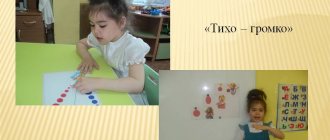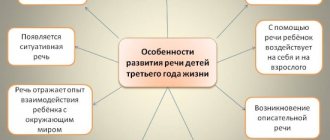The world is filled with thousands of sounds: the sound of rain, birdsong, car horns. We perceive sounds as an integral part of the surrounding reality, because it seems to us that we have always heard them. The auditory analyzer, which is responsible for the perception and recognition of sounds, actually develops and begins to work long before the birth of the child.
The unborn baby hears the mother’s voice, her heartbeat, and noises coming from outside. Therefore, many mothers share with each other memories that attending a rock concert in the late stages of pregnancy did not leave the unborn baby indifferent - he began to move.
But auditory perception develops even more actively after birth.
Having lived only 12 hours, the child already distinguishes human speech from other sounds, reacting to it with barely noticeable movements, and can accurately distinguish the mother’s voice from the voices of other people. Modern research shows that an infant is able to perceive the difference between a “native” and an “unfamiliar” language.
French linguist researcher Jacques Meller conducted an experiment in which four-day-old infants from families whose parents spoke French took part. The scientist used specially designed nipples that recorded the frequency of the baby's sucking movements. While feeding, the infants listened to a story recorded on a tape recorder, first in Russian and then in French. When infants heard French speech, they sucked more vigorously, whereas listening to Russian speech did not affect their behavior.
A child’s hearing develops at a rapid pace: at first, the newborn notices only those sounds that are located at a short distance (no more than 1.5 meters) from him. By the end of the year, the distance at which the baby perceives sound increases to six meters. A newborn is not familiar with the variety of environmental sounds. Throughout childhood, the child masters a kind of “sound vocabulary”, “memorizing” a huge number of everyday sounds - laughter, splashing water, creaking doors, squealing brakes, voices of animals, birds, people...
Hearing plays one of the leading roles in the development of speech: listening to the speech of others, the baby remembers the sound of words, rhythmic and intonation features of his native language. The memory of subtle sound nuances allows us much later, when talking on the phone, to accurately distinguish the voices of loved ones by their individual intonations.
In my office there is a young mother and a restless baby who is haunted by the toys on the shelf.
Poking her finger at them, she shows us that she wants to play with them. “Here,” my mother says annoyedly, “All she knows is to point a finger when she needs something.” But he can’t ask. But it’s almost three years, big one. Her peers have been speaking in sentences for a long time, but we only have shouts and gestures.
I just can’t understand why he still doesn’t speak. In our family, everyone started talking early - both me and my husband. I really want her to say...” After a long conversation with the mother and examination of the girl, I suggest that they undergo an examination by an audiologist (a specialist who deals with hearing disorders). Mom is surprised; she never expected that the delay in her baby’s speech development is associated with hearing loss. Unfortunately, this case is very typical.
Minor hearing loss is most often perceived by parents as the child’s inattention and therefore is almost not detected at an early age. Parents of children with severe hearing loss begin to suspect that “something is wrong” quite early, usually in the first or second year of the child’s life. They are alarmed by the baby’s obvious ignoring of loud sounds, lack of reaction to his own name, and delayed speech development. One worried grandmother brought her grandson to specialists after testing his hearing using the homemade “saucepan method” - the child did not turn to the sound of two lids hitting.
In the Russian Federation there are currently about 600 thousand children and adolescents with hearing impairment.
It is believed that per 1000 physiological births there is 1 child with severe hearing loss. Data on the prevalence of mild and moderate hearing loss still require clarification. This is due to the late referral of children’s parents to specialists, as well as the lack of alertness of pediatricians. In 1/3 of cases, mild and moderate hearing loss is first detected at the age of 3-7 years.
The auditory analyzer is the second human analyzer after the visual one, playing an important role as a component of obtaining information about the world around us. There is a close relationship between the state of hearing and speech development. Therefore, any, and even more severe, hearing impairment in the form of hearing loss and deafness has a great impact on the general and mental development of a growing child: untimely detection of hearing impairment in young children can lead not only to a delay in the speech, but also the intellectual development of the child.
Causes of hearing loss
There are many causes (or risk factors, as doctors call them) that can contribute to hearing loss, but they may not cause hearing loss on their own. Risk factors create a favorable background for the development of the disorder. In most cases, hearing loss is caused by several causes that operate during different periods of a child’s development. A child’s hearing system is especially vulnerable from the fourth week of pregnancy until the baby is four to five years old. Doctors identify three groups of reasons.
The first group is hereditary factors, when there have already been cases of hearing loss in the family. They lead to changes in the structures of the hearing system and the development of hereditary congenital hearing loss.
The second group is factors acting during pregnancy and childbirth, leading to congenital hearing loss. These include:
- infectious diseases of the mother during pregnancy (rubella, influenza, toxoplasmosis, herpes, syphilis, HIV infection, etc.);
- intrauterine fetal hypoxia (insufficient blood supply to the brain), caused by toxicosis in the first and second half of pregnancy, threat of miscarriage, pathology of the placenta, and blood pressure disorders;
- taking drugs during pregnancy with an ototoxic effect that damage the fetal auditory system (diuretics, antibiotics);
- mother's work in hazardous work during pregnancy;
- bad habits of the mother: alcoholism, smoking, drug addiction, substance abuse, etc.;
- injuries sustained by the mother during pregnancy;
- violation of the terms of gestation;
- adverse births and their consequences;
- hemolytic disease of newborns - a disease caused by incompatibility of the blood of mother and fetus;
- low body weight of the newborn (less than 1500 g);
- low Apgar score (a generally accepted method for assessing the condition of a newborn immediately after birth).
The third group is factors that act after birth on the hearing organ of a healthy child and lead to acquired hearing loss:
- past childhood infectious diseases (rubella, influenza, measles, mumps, meningitis, scarlet fever);
- taking ototoxic antibiotics, such as gentomycin, streptomycin, which destroy the hair cells of the cochlea, which causes persistent hearing loss;
- head injuries;
- psychological trauma caused by fear or stress;
- exposure to strong sharp sounds (for example, an explosion of firecrackers), constant exposure to loud sounds (in particular, listening to a player).
Behavioral signs of hearing loss appear quite early in children.
The newborn reacts to the sound by starting to move or opening its eyes slightly. Hearing a loud sound, the child shudders, freezes and may cry. Unlike a hearing child, a child with severe hearing loss is not frightened by loud sounds or reacts to the sound of a rattle or the ringing of a bell.
A child at the age of four months can turn his head towards the sound source, which is located to the right or left of him. A baby over six months old raises his head to look at the source of the sound, which is located above eye level. A one-year-old baby can locate the source of sound (localize sound in space) in all directions. So, if you are at a distance of one and a half meters from the child (out of his field of vision), your clapping or quiet whisper (for example, long stretching of the sound [c]) should make your baby turn his head towards you. Children with hearing loss do not look for the source of sound with their eyes and do not turn their heads in its direction.
Children with hearing impairments often do not respond to household noise (the hum of a vacuum cleaner, the sound of a radio, a ringing telephone). In order to hear even loud sounds, children with hearing loss need to get as close as possible to the source of the sound, so they like to sit next to a running washing machine, a TV or radio turned on at full volume. Even if the TV volume seems too loud to all family members, the child sits right next to the TV.
If the baby knows how to adjust the volume, he himself turns on the TV or radio at an excessively high volume. Reduced hearing is also indicated by the fact that the child cannot hear the speaker if he is outside his field of vision. When your child notices that he has been called (and you have to raise your voice), you may be surprised to meet his frightened or surprised look. Often such a child asks again, carefully watching the speaker’s facial expressions. A child with hearing loss cannot hear voices on the telephone or constantly moves the receiver from one ear to the other.
The most serious sign of possible hearing loss is insufficient or delayed speech development. In the first year of life, the pre-speech reactions (humming, babbling) of a child with hearing impairment are almost the same as those of a hearing baby.
A child with reduced hearing also develops a complex of animation - he smiles, actively moves his arms and legs in response to the voice and smile of an adult bending over him, he can coo and babble. However, by the end of the first year, babbling begins to fade, and then disappears altogether. A child with severe hearing loss can begin to speak only after special training from a teacher of the deaf, a specialist in hearing impairment. In children with moderate or slight hearing loss, speech appears at a later date compared to their peers, but the quality of speech suffers. A child with hearing loss does not babble during games and does not accompany his play with other vocalizations (pronouncing sounds, sound combinations).
If you are suspicious, observe how your child reacts to sounds. Lack of response to sounds sometimes means that the baby is simply not paying attention to them at the moment. However, it may also indicate certain hearing problems.
Examples of games and activities at 7 months
Danilka
Danechka - Danilka, You are my raspberry, Danechka - Danichek, I’ll give you a gingerbread! Danya-Danya-Daniil, the little bunny asked Danya: “Say “A-lu-lu!” “A-lu-lu-lu!” I'll share a carrot with you! I love Danechka!” (L. Pavlova) Valechka Valechka-Valyusha, Don’t be a screamer! Valechka - Valyusha, Say: “A-gu-gu-gu!” A goose is grazing in the meadow, He heard: “A-gu-gu-gu!” And he said: “I won’t run away!” (L. Pavlova) Sveta-Svetochka, Green twig, Light fluff, White snowflake! Svetochka-Sveta, Girl of Light! (L. Pavlova)
Calling the child by name, the adult looks into his eyes, smiles, gently touches his hands, and strokes his head.
When conducting games and activities with a baby who is not yet sitting, an adult takes this feature into account. Purely speech classes, where the mother engages in roll call with the baby, encourages the repetition of a familiar syllable (“ma”, “mu”, “li”, “gu”, etc.), shows the articulation of sounds, should be carried out with the baby lying on the back, facing an adult. The child should clearly see the speaker's face. The baby can be placed on a changing table, on the carpet or on mother’s lap, half-sitting, supported by an adult’s hand.
After speech exercises, the mother shows the child toys, plays with his hands and feet (nurturing), sings a song or reads a nursery rhyme or a fable.
Sample speech lesson “Poppy for Masha”
Task
Activate babbling and introduce the sound combination “ma” into the baby’s speech practice.
Material
Medium size doll (25-30 cm).
Content
The mother places the baby on the changing table. Calls you by name affectionately.
Then he invites the baby to roll call, showing the articulation of the sound combination “ma,” pauses for 10-15 seconds and repeats: “Ma-ma-ma!” If the baby responds, the adult continues the “dialogue,” allowing the baby to fully demonstrate his vocal capabilities. As soon as the baby falls silent, the adult again encourages him to interact verbally, repeating the syllable “ma-ma-ma.”
Then the mother shows the baby the doll and calls it by name: “Ma-a-sha”, “Ma-a-sha, little one!” Then he asks: “Where is Ma-a-sha?” And he answers: “Here is Ma-a-sha!”
Reads a poem (a nursery rhyme), where the desired syllable is repeated several times and is stressed:
For Ma-shenka, For little Ma-a-k Bright scarlet blossomed.
The mother turns the baby onto his tummy and places him on the carpet, placing a doll in front of him, thereby encouraging the baby to crawl. While playing with the child, she repeats a poem about Mashenka, she can sing it or recite it. Then you can show a scene with a doll: for example, how it walks or dances.
An approximate situation of speech communication “Hide and seek”
Tasks
Expand the child's social communication. Cultivate love for loved ones. Develop an understanding of adult speech, in particular, the words “mom”, “dad”, “grandmother” and others in combination with the question “where?” To consolidate and expand understanding of this issue.
Material
Two toys familiar to the baby, for example, Bunny and Cook's cockerel.
Content
The adult hides a toy that the child is accustomed to looking for in a constant place, for example, a cockerel Kuku.
He hides Bunny in another place in the same way. Then he turns to the baby with the question: “Where is Cook’s cockerel?” Not finding the toy in its usual place, the child is surprised. “Kuka hid! Let's go look. Kuka, where are you? - asks mom. She takes the baby in her arms and they begin searching for the toy. The adult accompanies his actions by repeating the question: “Where is Cook?” Finally the cockerel was found. An emotional scene of a meeting with the cockerel Kuka is played out. The toy is put in place. A similar game happens with Bunny.
Then the mother expands the meaning of the question “where?”, inviting the baby to look where grandma is. She takes the child in her arms, the search for the grandmother begins: “Baba, where are you?” (Grandma hid behind a door, curtain, chair, etc.).
Mom emotionally plays out the search and the moment of finding her grandmother. This scene is accompanied by laughter and joyful communication. The grandmother caresses the baby, hums some funny nursery rhyme:
Ay, kachi-kachi-kochi! Let's bake some rolls, the rolls are hot! Get out of the oven! (Russian nursery rhyme)
At this moment, mom hides unnoticed. The plot is repeated with the participation of a second adult family member: “Where is mom? Mom, where are you? The search is accompanied by bright game moments and positive emotions:
Ay, okay, okay! Ladushki - palms! We play ladushki, we amuse Baby (child’s name)! (Russian nursery rhyme)
If the baby is not tired, the grandmother hides again. Again the question sounds: “Baba, where are you? Where is grandma? The game repeats itself. Its peculiarity is “surprise”, unexpectedness, when the question “where?” is combined with a result-answer that is understandable to the child: “That’s where!” Found!"
An approximate finger game for developing speech understanding “Our Hands”
Task
With your child, learn hand movements performed to the song (or speech) of an adult.
Content
The mother plays with the child’s hands: with slight movements, turning and waving one or the other palm. Sings:
Our hands are birds, sparrows, titmice! (g times) The child’s arms rise, touch his head. K-shi... Let's fly! They sat on their heads! Like this, like this, they sat on their heads! (The song is performed to the tune of “Bayu-bayushka” cheerfully, at a fast pace).
Sample lesson on understanding the names of objects “What is this?”
Tasks
Create situations that can interest the child and encourage him to babble and vocalize. Help you remember the names of familiar toys (cockerel, bunny, bell, drum). Develop crawling.
Material
Toys (2-3 pcs.) Napkins.
Content
The mother places toys on the carpet at some distance from the baby and covers them with napkins.
Then he encourages the child to crawl to the toy, asking: “What’s there?” The kid pulls off the napkin and discovers an object. Mom names the toy, for example: “This is Cook’s cockerel” or “This is Masha’s doll.” So the baby sequentially opens all the toys. He repeatedly hears interrogative speech structures: “What’s there?”, “What’s that?” - and the answer: “This is Kuka,” “This is Masha.” Next, the toys discovered by the baby are used in the game.
A purely speech lesson with a child can last 2-3 minutes. Lesson using toys, demonstrations and physical activity - 6 min.
Baby's achievements at 7 months
If the child was given sufficient attention and the age-related characteristics of pre-speech development were taken into account, then by the end of the 7th month he will delight you with his successes:
- The baby babbles for a long time. He is able to repeatedly pronounce 2-3 identical syllables.
- Enters into a roll call with an adult if he is encouraged to do so.
- Understands the intonations of an adult’s speech, reacts differently to the joyful and sad notes of his voice.
- Responds emotionally to speech.
- To the question “where?” points with a finger at familiar toys located in the same place.
How to check if your baby can hear?
The sounds that surround us in everyday life, including the sounds of speech, have different volumes and different frequencies. The volume of sounds in acoustics is measured in Decibels, and the sound frequency is measured in Hertz.
Depending on their physical characteristics, sounds are:
- low-frequency - the sound of a passing truck, the sound of a jackhammer, and in speech - the sound [n], [m].
- mid-frequency - the sound of a piano, the cry of a baby, and in speech - the sounds [p], [g].
- high-frequency - rustling leaves, birdsong; speech sounds - [c], [f], [ts].
When hearing loss occurs, a person's ability to perceive sounds of certain frequencies, primarily high-frequency sounds, is reduced.
To conduct the examination you must prepare:
1) Three identical film cans, or Kinder Surprise capsules. Pour one third of semolina into jar No. 1, buckwheat into jar No. 2, and peas into jar No. 3.
2) You will need a squeaky toy, which your baby probably has. In the study you will conduct, the squeaky toy is a high-frequency sound stimulus, and the cereal boxes produce sounds at different volume levels:
- semolina - approximately 30 - 40 dB;
- buckwheat - approximately 50 - 60 dB;
- peas - approximately 70 - 80 dB.
Social-emotional development of children 8 months
At 8 months, children begin to experience a separation crisis: the baby realizes that he is capable of much, and even tries to show independence, but the fear of being separated from his mother is much stronger. Therefore, many parents notice that children become more whiny and require more tactile and emotional contact. If previously they could easily make contact with a stranger, now attempts to pick up the baby in their arms can turn into hysterics.
And yes, now, if you ask a child where his mom or dad is, he will confidently look at them.
How is the examination carried out?
IMPORTANT! It is necessary that the baby is calm at the time of the examination. It is better to choose one of the periods of wakefulness between feedings for this.
A child who does not yet know how to sit is placed on a changing table. The table should be positioned in such a way that it can be approached from the right and left.
The mother can sit a child older than 6 months on her lap.
Ask someone close to you to help you. Two people must take part in the examination: an observer and an assistant. The observer bends over the child and tries to attract the child's attention to the bright toy by moving it to the right and left. The observer’s task during the examination is to see the child’s reaction to the sound (freezing, listening, activation or inhibition of general movements, widening of the palpebral fissures, turning the eyes or head towards the sound source).
At the moment when the child looks directly at the toy or at the observer’s face, the assistant behind him, at a distance of 10 cm from the child’s ear, begins to shake the box.
When conducting the examination, the following rules must be strictly observed:
1) To obtain reliable data on the child’s hearing condition, the examination should be carried out from quiet sounds to loud sounds. Sound signals should go in the following sequence: a) semolina; b) buckwheat; c) peas. If this sequence of sounds is disrupted, a child who “reacted” to a loud sound may simply not notice a quiet one.
2) The intervals between signals must be at least 30 seconds. (In order for the previous reaction to fade away).
3) When giving sound signals, you must be sure that the child does not see your hand with the “noise” jar hidden in it.
4) The examination procedure is carried out in each ear in turn.
Overprotection or indifference on the part of parents
If parents go too far in matters of upbringing, show intolerance or misunderstanding, then the child instinctively tries to avoid any communication with them. With strangers and peers on the playground or in kindergarten, he often continues to behave as usual.
Solution: In this case, the help of a psychologist is needed, and it is advisable that both parents and the child come to the session. Mom and dad should reconsider their behavior and attitude towards the baby. Most likely, the reason is really too high demands or, conversely, complete disregard for the interests of the son or daughter. Excessive guardianship does not allow the child to express his opinion, and here silence should be considered as a sign of protest.
What reaction of the child indicates that hearing is within the physiological norm?
A child from 0 to 6 months should respond to the sound of a decoy and a squeaker toy.
A baby over 6 months old must respond to all proposed sound stimuli.
If the child does not respond to the sound of a semolina and a squeaking toy, try repeating the examination procedure after a while. The child’s reaction to sound may have a hidden “delayed” period (especially if your child is premature or somatically weakened). Hearing loss may be suspected if the result is negative again. In this case, immediately contact a children's clinic or specialized center to see an audiologist (hearing impairment specialist).
Please read this table carefully. Your observations of the child’s behavior will become additional valuable information for specialists.
Baby becomes silent in front of strangers
Silence is a natural defensive reaction of the body when a child encounters a stranger, especially if he seems scary or simply somehow incomprehensible. Lack of speech may occur for several hours after the meeting.
Solution: If your baby fell silent immediately after your meeting with a stranger, then most likely he will speak before going to bed. Be sure to have a friendly conversation with him about the stranger, tell him that he is a good person who poses no danger, and that his parents like to communicate with him. The child should feel that you are completely safe with him, and next time he will worry less.
Signs of possible hearing loss
| End of 1st month | In response to an unexpected and loud sound: there is no inhibition of general motor or sucking movements, does not flinch, does not blink. |
| End of 2nd month | Does not listen to the ringing of a bell (at a distance of one and a half meters). |
| End of 3rd month | Doesn't look for the object that makes sounds with his eyes, doesn't turn his head to the right, left or towards the source of the sound. Does not respond to musical toys. |
| End of 5th month | Doesn't stop crying when he hears music or his mother singing. |
| End of 6th month | Does not react to the rustling of paper that is outside his field of vision. |
| End of 7th month | Does not turn towards the sound source or the person speaking. Doesn't smile when you talk to him. |
| End of 8th month | Does not listen to adults' conversations. Doesn't freeze when hearing a new sound. Shows no interest in music. Doesn't babble. |
| End of 9th month | Doesn't respond to his own name. Doesn't understand the word "no" or prohibition. Doesn't play "talk" with you. |
| End of 10th month and 11th month | Babbling is either absent or “monotonously” colored. Doesn't use his voice to attract attention. |
| End of 12th month and older | At the request of an adult, does not point at people or familiar objects. Does not imitate simple sounds and monosyllabic words. Does not respond to quiet sounds made outside his field of vision. Does not turn his head towards the source of sound (both quiet and loud). Doesn't understand simple calls. Shows no interest in everyday sounds or music. Doesn't try to talk. |
You should definitely contact an audiologist if:
- You notice the signs of hearing loss described above in your baby;
- A whitish or yellowish fluid is discharged from the child's ear. In such cases, the baby does not always show anxiety or complain of unpleasant or painful sensations. However, such discharge may indicate inflammation of the middle ear;
- The child grabs his ears, hits them, rubs them and cries. The cause of this condition may be an infectious disease that requires immediate treatment. Otherwise, this may lead to irreversible damage to the organ of hearing;
- The baby covers his ears and cries when he hears an overly loud sound.
Signals of delayed speech development in a child
One of the main indicators of a child’s mental well-being is timely speech development that corresponds to age standards. After all, speech is not only a means of communication, but also the main tool of thinking, a gateway into the world of knowledge and the development of a child as a person.
The reasons in a nutshell
The reasons for difficulties in mastering speech can be different. For example, hearing loss, early brain damage (birth injuries, prematurity, infections, etc.), genetic background can lead to a delay, despite exemplary communication between parents and children.
But there are other, extreme examples that each of us has seen: an upset child cries, a capricious or tired child screams - the parent “shuts up” him with a pacifier and gives him a gadget, enjoying the reigning peace and quiet. Social and pedagogical neglect may look different, but the essence remains the same: the child experiences a communicative hunger and does not receive high-quality and sufficient stimulation of the speech areas of the brain. In such cases, it is at least not logical to count on the timely development of speech.
What to pay attention to
A specialist (pediatrician, neurologist, child neuropsychologist, child psychiatrist) will find out the reasons when you contact him: he will give recommendations to the family, and refer you to related specialists, if required. But timely treatment, that is, recognition of the problem, is sometimes determined by the responsibility and awareness of the parents.
- The child does not freeze or focus on you when you talk to him
In the first month of life, a normally developing baby begins to react to the voice of another person: it becomes quiet, as if listening. In the third month of life, the child fixes his gaze on the speaker and expresses emotional responses (smile, animation).
2. Monotonous humming
By the third or fourth month of life, the child begins to hum , alternating vowel sounds (mainly “a”, “u”, “e”) with overtones similar to a soft “g” or “x” (the classic “agu-aghu”). Often the child responds with such melodious syllables to speech addressed to him. If a child in the fifth or sixth month drones stereotypically, without changing intonation, without listening to his own voice, then this may indicate a hearing impairment. If the humming is very scanty or completely absent, this may be a sign of severe pathology. In both cases, it is necessary to contact a specialist (children's neurologist, pediatrician).
3. No babbling. Monotonously intonated babble
By the eighth to tenth month, the humming gives way to babbling - repeated syllables consisting of vowels and consonants. At first this repertoire is simple: “mamamama”, “uncle”, but as the child develops it becomes more complex, the syllables become more diverse, ri, “mya-la-nya”, etc. appear. What should make parents wary is monotonous, undeveloping, uncomplicated babbling, as well as the child’s lack of babbling words (“mama,” “baba,” “dad,” “am,” “give,” “bang.” ).
4. Poor vocabulary, lack of attempts to pronounce “adult words”
By approximately 1 year and 8-9 months, the child masters words with non-repeating syllables (“kisya”, “aunt”), and also demonstrates attempts to pronounce words with three syllables (“ofka” - “cow”, “sinya” - “car” ). The active vocabulary (i.e. words that the child is able to pronounce himself) has 20 - 40 words. If a child at this age prefers to use his old dictionary, it makes sense to take a closer look at the development of his speech, try to enrich his speech environment more richly (talk more, read books, play together).
5. Absence of simple sentences in speech by two years
At two years old, the active vocabulary grows to 50-200 words. The child begins to use the simplest sentences heard from adults (“Let’s go for a walk”, “It’s time to sleep”), and also tries to construct sentences on his own (“Kisya go”, “Baba, give me!”). If the baby does not make such attempts, it is worth considering whether enough has been done to develop his speech.
6. Inability to classify objects by three to four years of age
At this age, the active vocabulary ranges from 1000 to 2000 words. The child already understands that the word “cat” means not only his cat, but all cats in general, and “mother” means not only his cat, but all mothers. Children learn to categorize objects: they know, for example, that a plate, fork, cup are utensils, and a dog, hare, cow are animals. If by the age of four this understanding is not yet available to a child, you should be alarmed; perhaps the baby is developmentally delayed or has memory problems.
7. Poor speech, lack of developed speech by age five
At five years old, a child is capable of both dialogue (answering questions) and monologue speech. He uses verb tenses, pronouns, prepositions, prefixes and suffixes (“Arrived - left”, “chair - chair”). For all this, it is necessary that the baby has a sufficiently developed understanding of space and time. If a child avoids such complex words, makes do with nouns or verbs, and speaks in monosyllables by this age, this is an unfavorable sign and you should consult a specialist.
8. The child has “porridge in his mouth”, it is difficult to understand what he is saying
The age of physiological tongue-tiedness, when a child incorrectly pronounces some sounds due to an insufficiently developed articulatory apparatus, ends by the age of four. If the child’s speech is unintelligible after this age stage, then this is a reason to seek the advice of a specialist.
9. Speech stamps
It happens that a child surprises everyone with his rich, detailed speech. He may even enjoy “showing off” his monologues in front of adults and other children. However, in the dialogue it turns out that the child finds it difficult to answer even simple questions, construct sentences, express his thoughts and very quickly gets tired of such a conversation, transferring it to a well-learned topic. This happens if a child who has problems in speech and, as a rule, mental development, compensates for this deficiency with a well-developed memory, and recites (sometimes quite large) passages from his favorite books, cartoons, and songs.
Instead of a conclusion
Everything that has been said once again suggests that the situation in which a child does not speak at all by the age of three, and even more so by four years , is completely atypical. In any case, such a situation (even if “it’s a family thing, dad didn’t speak until he was five” or “grandfather was completely silent until he was seven”) requires the attention of professionals.
It happens that a child’s speech disappears or is distorted after suffering traumatic events, or as part of the course of a mental illness. Early identification of these conditions also facilitates timely care.
If any of the above is noticed in a child, you should not wait for “sea weather”, wasting precious time. Developing at first, as if in parallel, thinking and speech at a certain stage (starting from 2.5-3 years) close and spur each other’s development: thinking becomes verbal, and speech becomes more and more meaningful. From here it is easy to conclude: without receiving “support” from speech, the child’s thinking is delayed at an earlier stage of development than the thinking of his “speaking” peers. Thus, a child who does not receive timely help and does not learn to operate with speech, in the worst case scenario, can “earn” secondary mental retardation.
Autism spectrum disorders in children may also be accompanied by delayed speech development. It is not uncommon in autism to have a situation where, until a certain age, a child’s speech development corresponded to his age or even advanced – babbling appeared, the first words appeared, but then the skills were lost. It is very important to undergo a timely examination by a child psychiatrist to exclude and confirm the diagnosis of early childhood autism. Unfortunately, in a children's clinic, psychiatrists have very heavy workloads and there is not always enough time and tools for a full diagnosis during routine examinations at 2 years of age. In our center, several qualified doctors know the most modern methods of examining children for the early detection of autism spectrum disorders. It is better to play it safe and exclude the presence of such a disease in a child, but if it is nevertheless detected, then the early start of treatment and rehabilitation measures is the key to ensuring that the child will be able to adapt as much as possible and develop his skills.
There is no need to be afraid of a visit to a child psychiatrist in our center. The examination data is confidential information, the child will not be “registered” and the fact of the application will not be transferred anywhere to third-party organizations. Based on the results of the examination, a rehabilitation plan for the child will be drawn up, and special techniques will be selected depending on the established cause of delayed speech development. In some cases, drug treatment may be required, but medications alone cannot solve the problem; there is no “magic pill” that develops speech. Medicines can only make it easier for a child to study according to a properly selected program.
Contacts with specialists
An effective method for diagnosing the state of hearing in young children (from birth) is objective computer audiometry (COA). The results of this study allow the audiologist to judge not only the presence or absence of hearing in a child, but also determine the degree of hearing loss.
This test is typically performed in pediatric departments of ear, nose, and throat research institutes and pediatric audiology centers. Such a study is sent if one of the listed risk factors is detected in the newborn or if, at the first examination, an otorhinolaryngologist (ENT doctor), pediatrician or neonatologist (doctor who monitors newborns) suspects hearing impairment. Recently, primary research has been carried out using a sound reactotest - a special device designed for the early detection of hearing loss in children. Currently, this device is available in almost all children's clinics.
If your child is diagnosed with hearing loss, your audiologist will tell you whether you need a hearing aid or other treatment options. In addition, your child will need special classes with a teacher of the deaf, without which he will not learn to perceive sounds and speak. The earlier the child’s education begins, the higher the likelihood that the child will be able to master spoken language, study in a public school, and receive vocational training.
Disease
In some cases, speech disappears if the infection has affected the organs of the respiratory system and caused an increase in body temperature. This happens especially often in very young children who are just starting to speak. In more severe situations, the infection affects the speech centers of the brain and auditory receptors.
Solution: As a rule, speech is restored to its previous volume after recovery from colds, so special help is not required. If the child has suffered a severe infection, he should be immediately checked by a neurologist and otolaryngologist. The sooner treatment and correction are started, the more speech will return to the baby.
How to properly communicate with a child with hearing loss?
When talking to your child, make sure he can see your lips. Reading lips is very important for him. If you want to draw your child's attention to a toy (or object), bring it to your lips and talk about it, holding it at mouth level. Talk to your child with your lips 10-15 centimeters away from the baby's ear, or increase the strength of your voice.
Don't be afraid to use meaningful gestures. You can come up with a whole system of gestures that only you and your child can understand. These gestures have nothing to do with the “deaf language” that many parents fear. They will help your child learn to understand the meaning of many words and communicate with you until he learns to speak.
Rich facial expressions can be an additional tool that will help your baby understand speech addressed to him. Exaggerated facial expressions of joy, fear, delight, fear will allow the child to better understand what you want to tell him. Teach your child to express his desires and needs using the means of communication available to him - gestures, facial expressions, intonation, words.
The child stopped speaking at the age of 1-1.5 years, although he already knows several babbling words.
Most often, the baby refuses to speak because the parents demand too much from him and force him to repeat words over and over again. Such small children are simply not ready for such stress, so they become silent due to extreme fatigue.
Solution: Leave the baby alone, do not put pressure on him. When he speaks again, don't repeat the same mistakes. The return of speech may take several days or a month. There is no need to panic, but be sure to show your child to a neurologist to rule out diseases of the central nervous system.
Nutrition for boys and girls 8 months
As before, the basis of the baby’s diet remains breast milk or its substitute - an adapted milk formula. But besides this, more and more complementary foods appear in a child’s life. The essence of introducing complementary foods is familiarization with new tastes and textures, visualization of food (before this he had not seen the milk he ate), introducing the child to his family’s table and completely replacing milk or formula in the future. By this point, children are most often already familiar with vegetables, cereals and pureed meat. By 8-9 months, you can add boiled yolk and fermented milk products - cottage cheese or kefir - to the diet.
In addition, 8 months is the optimal age for introducing kibble complementary foods. You should start with small “cubes” no larger than 0.5 * 0.5 cm of soft consistency (for example, zucchini), so that the child can bite it with his gums if something happens. Do not forget that the introduction of “pieces” is an important stage in the baby’s development! Experts believe that if this is not done before 12 months, the chewing reflex will begin to fade.











